Georgia’s skies are adorned with diverse hawks, each showcasing unique characteristics and ecological roles within the state’s varied landscapes.
Among the many species soaring through the southern skies, six hawks stand out with their distinctive features and behaviors.
From the iconic Red-Tailed Hawk, known for its broad red tail, to the elusive Northern Harrier, characterized by its low gliding flight, Georgia’s avian residents offer birdwatchers and nature enthusiasts a captivating glimpse into the fascinating world of raptors.
Explore the striking adaptations, hunting strategies, and habitats of these six hawk species that contribute to Georgia’s natural tapestry’s rich biodiversity and ecological balance.
Why There Are Few Species of Hawks in Georgia?
The diversity and distribution of hawk species in Georgia are influenced by a combination of ecological, environmental, and geographical factors.
While Georgia has a variety of hawks, the number of species may seem relatively lower compared to other regions. Several factors contribute to this observation:
Habitat Suitability
Hawks exhibit specific habitat preferences, and the availability of suitable habitats can limit the number of species in a particular area.
Georgia’s landscape consists of diverse ecosystems, including forests, grasslands, and wetlands, but certain hawk species may be more adapted to other regions.
Migration Patterns
Some hawk species are migratory and may only be present in Georgia during specific seasons. Their absence for most of the year contributes to the perception of fewer species.
Competition with Other Raptors
Hawks compete with other birds of prey for resources, including nesting sites and food. The presence of other raptors in Georgia may influence the diversity and distribution of hawk species.
Human Impact
Urbanization, habitat destruction, and human activities can negatively impact hawk populations. Loss of suitable nesting sites and exposure to environmental contaminants may affect the overall diversity of hawks in the region.
Climate and Geography
Georgia’s climate and geography may be more conducive to certain hawk species than others. Factors such as temperature, precipitation, and terrain play a role in shaping the distribution of hawk species.
It’s important to note that the apparent “fewness” of hawk species in Georgia is relative, and the state still supports a variety of hawks, including species like the Red-tailed Hawk, Cooper’s Hawk, and Red-shouldered Hawk.
Conservation efforts, habitat protection, and awareness can contribute to maintaining and enhancing hawk diversity in Georgia over time.
6 Hawks of Georgia
In the diverse landscapes of Georgia, a tapestry of hawk species graces the skies.
From the iconic Red-Tailed Hawk to the elusive Northern Harrier, explore the captivating world of these raptors, each embodying unique adaptations and ecological roles within the state’s rich habitats.
1. Red-Shouldered Hawk
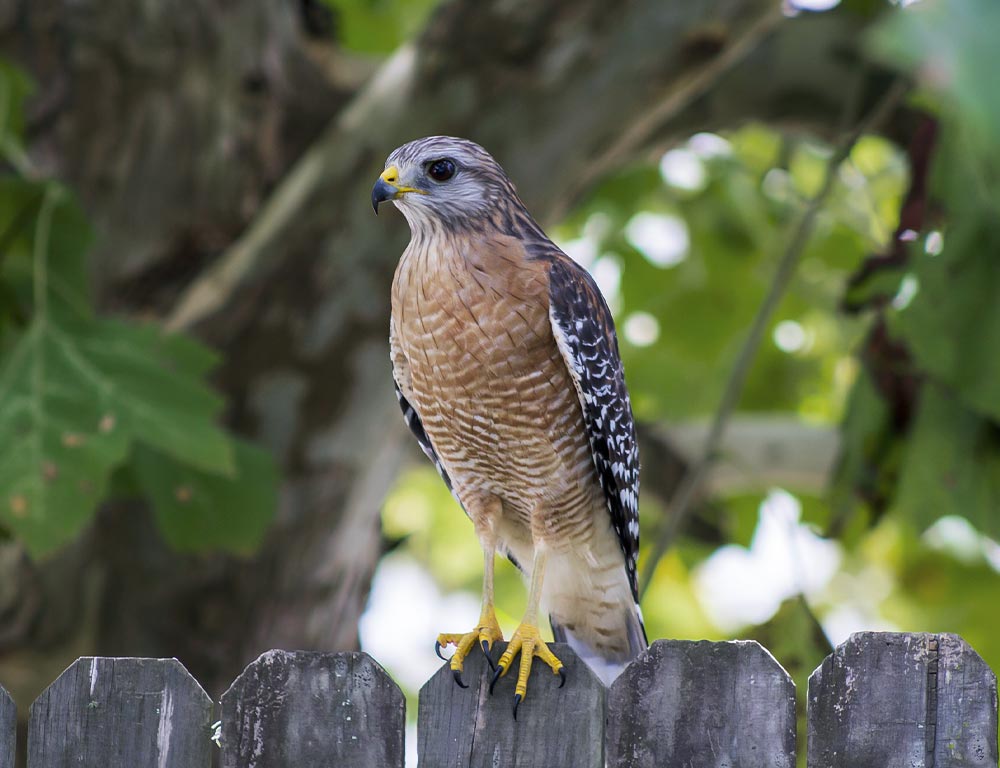
- Scientific Name: Buteo lineatus
- Category: Hawk
- Population: Common, with stable populations
- Life Span: Up to 15 years
- Size: 17 to 24 inches in length
- Weight: 1 to 2.5 pounds
- Food: Varied diet, including small mammals, reptiles, amphibians, and birds
- Wingspan: 37 to 43 inches
- Status: Least Concern
The Red-Shouldered Hawk is a common and striking raptor found throughout Georgia. With its distinctive reddish-brown shoulders and loud vocalizations, these hawks inhabit wooded areas, swamps, and riparian zones.
Their diet includes small mammals, reptiles, amphibians, and birds, and they are known for their characteristic soaring flights.
Red-shouldered hawks are monogamous and build stick nests in the upper canopy of trees. Their populations remain stable, reflecting their adaptability to varied habitats within the state.
2. Sharp-Shinned Hawk
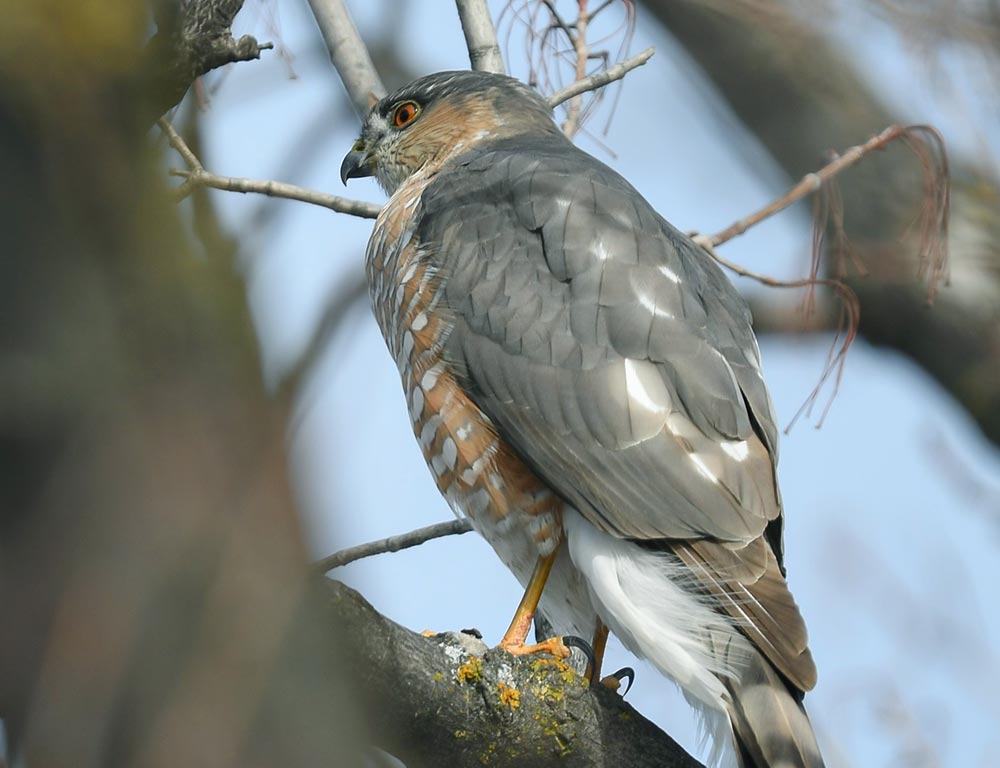
- Scientific Name: Accipiter striatus
- Category: Hawk
- Population: Stable, with regional variations
- Life Span: Up to 7 years
- Size: 9 to 14 inches in length
- Weight: 3 to 7 ounces
- Food: Mainly small birds, occasionally small mammals and insects
- Wingspan: 16 to 22 inches
- Status: Least Concern
The Sharp-Shinned Hawk, known for its agile flight and short wings, is a small but swift predator found in Georgia. These hawks primarily prey on small birds, utilizing dense vegetation for ambush-style hunting.
Their populations are generally stable, with regional variations. As migratory birds, they traverse through Georgia during their seasonal movements.
Sharp-shinned hawks are well-adapted for maneuvering through wooded areas, displaying exceptional speed and precision in capturing their avian prey.
3. Broad-Winged Hawk
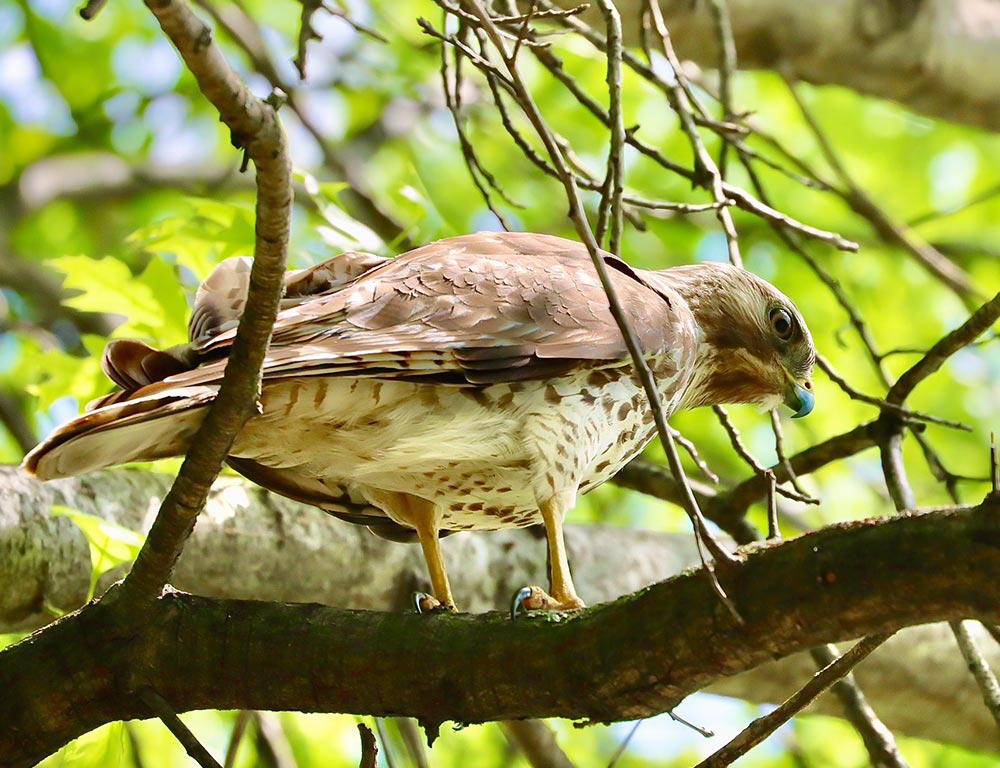
- Scientific Name: Buteo platypterus
- Category: Hawk
- Population: Common, with stable populations
- Life Span: Up to 4 years
- Size: 13 to 17 inches in length
- Weight: 9 to 20 ounces
- Food: Small mammals, birds, reptiles, and amphibians
- Wingspan: 28 to 37 inches
- Status: Least Concern
The Broad-Winged Hawk, known for its distinctive call and soaring flights, is common in Georgia’s forests and wooded habitats. These hawks have a broad diet, including small mammals, birds, reptiles, and amphibians.
They are recognized for their migratory behavior, often forming large flocks during their journeys. Broad-Winged Hawks successfully maintain stable populations despite a relatively short lifespan of up to 4 years.
Their preference for wooded landscapes and their migratory patterns make them an integral part of Georgia’s rich avian diversity.
4. Northern Harrier
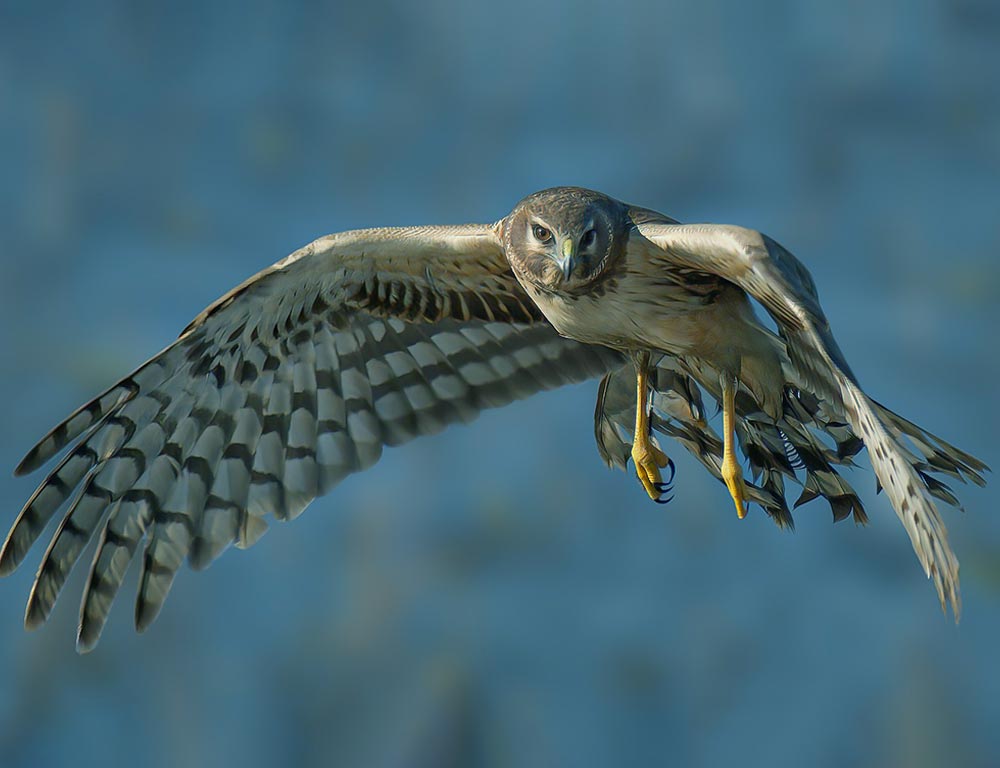
- Scientific Name: Circus hudsonius
- Category: Hawk
- Population: Varied, populations declining in some regions
- Life Span: Up to 10 years
- Size: 18 to 24 inches in length
- Weight: 10 to 26 ounces
- Food: Small mammals, birds, and insects
- Wingspan: 40 to 48 inches
- Status: Least Concern
The Northern Harrier, characterized by its distinctive facial disk, is a medium-sized hawk who prefers open habitats.
Often observed gliding low over fields, marshes, and grasslands, they employ their keen hearing and vision to hunt small mammals, birds, and insects.
Northern Harriers are known for their owl-like facial features and distinctive hovering behavior while hunting.
In some regions, populations are facing declines due to habitat loss, making conservation efforts vital to ensure their continued presence.
5. Red-Tailed Hawk
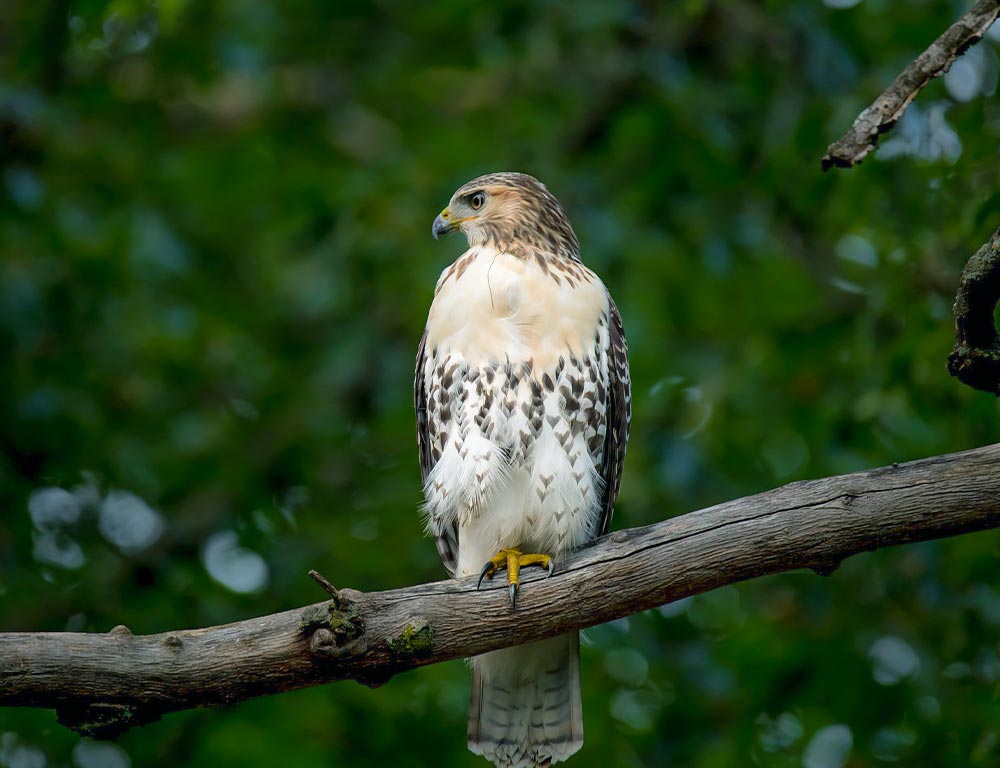
- Scientific Name: Buteo jamaicensis
- Category: Hawk
- Population: Abundant and widespread, with stable populations
- Life Span: Up to 21 years
- Size: 18 to 26 inches in length
- Weight: 2 to 5 pounds
- Food: Varied diet, including small mammals, birds, reptiles, and carrion
- Wingspan: 43 to 57 inches
- Status: Least Concern
The Red-Tailed Hawk, one of the most widespread and recognizable raptors, thrives across various habitats in Georgia. Known for its broad, red tail, these hawks are adaptable and exhibit diverse color morphs.
With a diet ranging from small mammals and birds to reptiles and carrion, Red-Tailed Hawks play a crucial role in ecological balance.
Their soaring flights and characteristic calls make them familiar, and their stable populations indicate successful adaptation to human-altered landscapes.
6. Cooper’s Hawk
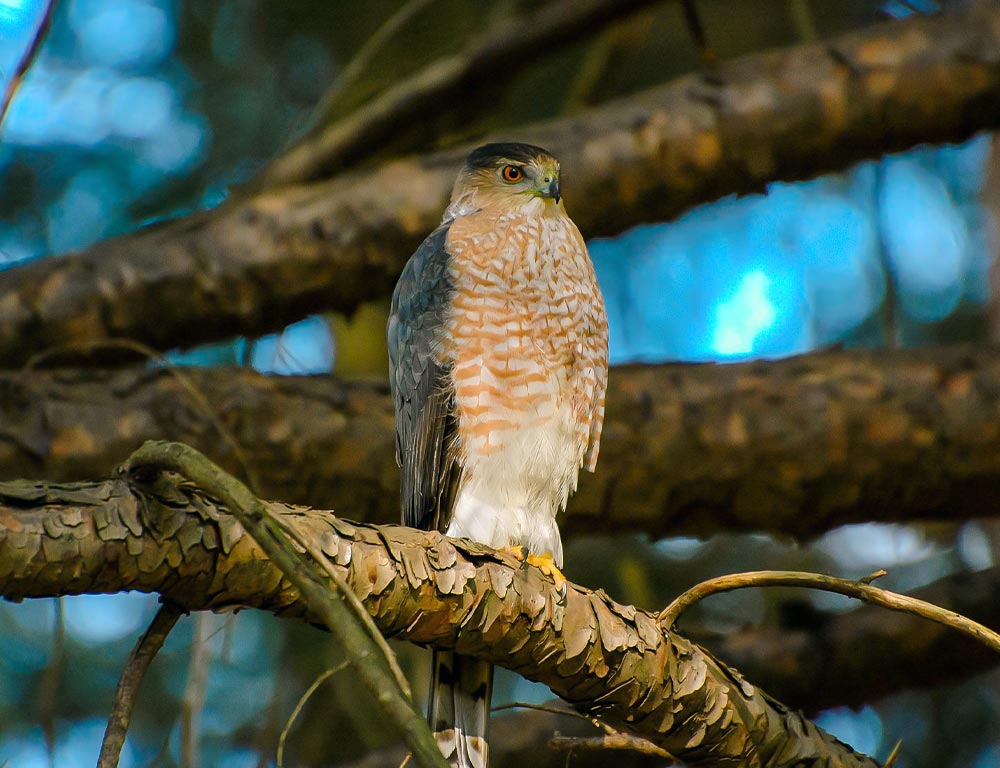
- Scientific Name: Accipiter cooperii
- Category: Hawk
- Population: Stable, common in various habitats
- Life Span: Up to 12 years
- Size: 14 to 20 inches in length
- Weight: 7 to 24 ounces
- Food: Mainly birds, occasionally small mammals
- Wingspan: 24 to 35 inches
- Status: Least Concern
Cooper’s Hawks are agile woodland hunters, well-adapted for maneuvering through dense vegetation. With a preference for avian prey, they are often observed darting through forests and suburban areas in pursuit of smaller birds.
Their populations remain stable, reflecting their ability to coexist with human development. Cooper’s Hawks exhibit sexual dimorphism, with females being larger than males.
Their hunting strategies, characterized by surprise attacks, contribute to their success in capturing agile prey. As versatile predators, Cooper’s Hawks are important in controlling bird populations and maintaining ecological balance.
Best Places to Spot Hawks in Georgia
Georgia’s diverse landscapes offer numerous opportunities for spotting various hawk species.
Whether you’re an avid birdwatcher or a nature enthusiast, here are some of the best places in Georgia to witness the majestic flights and hunting prowess of hawks:
Amicalola Falls State Park
Located in the North Georgia mountains, Amicalola Falls State Park provides scenic overlooks and open spaces where hawks can be observed soaring against the backdrop of cascading waterfalls.
Okefenokee Swamp
With its vast wetlands and diverse ecosystems, the Okefenokee Swamp is home to various bird species, including hawks. Boat tours offer an opportunity to spot these raptors in a unique habitat.
Altamaha Wildlife Management Area
This expansive wildlife management area along the Altamaha River provides a mix of woodlands and open fields, creating an ideal environment for various hawk species.
Cloudland Canyon State Park
Nestled on the western edge of Lookout Mountain, Cloudland Canyon State Park offers panoramic views and open skies where hawks, including Red-Tailed Hawks, can be observed during their flights.
Charlie Elliott Wildlife Center
With diverse habitats, including forests and lakes, Charlie Elliott Wildlife Center attracts a variety of bird species, making it a great location for observing hawks in their natural environment.
Red Top Mountain State Park
Situated on the shores of Lake Allatoona, Red Top Mountain State Park provides a mix of woodlands and open spaces, creating opportunities to spot hawks, especially during their migrations.
Fort Pulaski National Monument
Located near Savannah, Fort Pulaski National Monument features a combination of marshes and historical structures, providing a unique setting for observing hawks, including those adapted to coastal environments.
Chattahoochee National Forest
With its diverse terrain, the expansive Chattahoochee National Forest is home to various hawk species. Hiking trails and overlooks offer excellent vantage points for birdwatching.
Sapelo Island National Estuarine Research Reserve
A coastal gem, Sapelo Island provides a habitat for hawks adapted to maritime environments. Boat tours around the island may offer glimpses of these raptors.
Piedmont National Wildlife Refuge
The Piedmont National Wildlife Refuge, with its mix of hardwood forests and grasslands, provides an ideal setting for observing hawks, including those that prefer wooded habitats.
When exploring these locations, it’s essential to bring binoculars, be patient, and respect the natural behaviors of these magnificent birds.
Each site offers a unique experience to witness the beauty and behavior of hawks in Georgia’s diverse ecosystems.
Wrapping Up
In the vast expanses of Georgia, the lives of six distinct hawk species unfurl, adding vibrant hues to the state’s skies.
From the majestic Red-Tailed Hawk to the elusive Northern Harrier, these raptors embody resilience and adaptability, playing integral roles in maintaining ecological harmony.
By exploring their behaviors, habitats, and unique features, we gain a glimpse into the diverse world of hawks and a profound appreciation for their contributions to Georgia’s rich biodiversity.
As we observe their soaring flights and hunting prowess, it becomes clear that these hawks are not mere inhabitants; they are guardians of the skies, emblematic of the intricate balance that sustains the natural beauty of the Peach State.